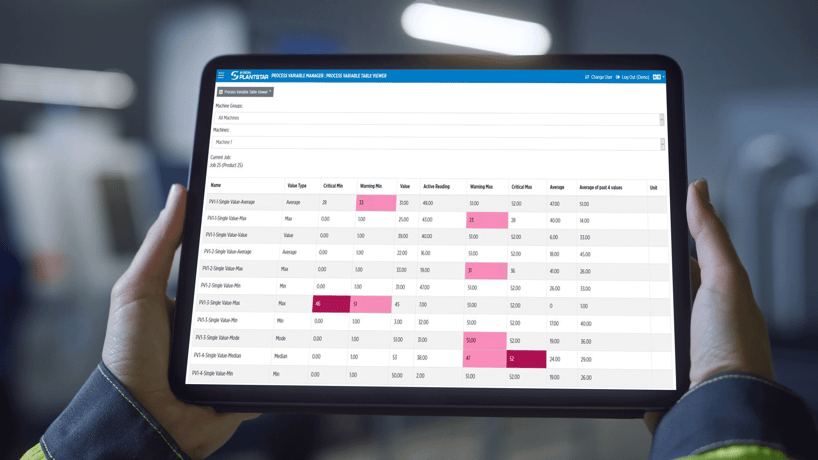PlantStar BLOG
What to Expect From MES Technology in 2022 and Beyond
Feb 17, 2022 5:02:00 PM / by David Crowley

Manufacturer processes are in a constant state of flux as suppliers incorporate the latest and greatest technology to gain a competitive edge. Industry 4.0 is a concept where factories become smarter, more automated, and more efficient. To turn that vision into reality, manufacturing industry suppliers must embrace the Internet of Things (IoT), real-time data, artificial intelligence, automation, and digital transformation.
The growing use of IoT in factories has led to the advancement of MES systems, which is an enterprise system that focuses on real-time monitoring, synchronization, and analysis of data from plant equipment. An MES integrates manufacturing processes into an overall manufacturing execution system that improves efficiency, reduces variation, and increases productivity.
Integrating all of these systems requires manufacturers to manage a great deal of data across many types of machines. Analytics software can help manufacturers identify patterns in the data and make better-informed decisions about the factors that influence the performance of transient products, such as temperature, pressure, flow rate, torque, speed, and more.
Manufacturers are already tapping into analytics to keep their plants at peak operating efficiency. By combining sensor data with other data sources, manufacturers are able to detect problems before they cause an issue in production. Analytics can also highlight potential improvements throughout the entire supply chain. For example, because it has real-time visibility into its entire supply chain, a manufacturer may be able to reduce costs when material prices change or deal with unexpected issues quickly to avoid serious financial losses.
The future promises more advanced MES systems with additional capabilities including predictive maintenance, proactive asset optimization, and the ability to integrate intelligent machines on the factory floor. Here are some of the advances and trends manufacturers can expect in 2022 and beyond.
1. IoT Reshapes Manufacturing
Traditional factory equipment was dumb and broke down randomly. As a result, suppliers managed their production runs reactively rather than proactively. IoT adds intelligence via special-purpose sensors to smart factory floor equipment. Suppliers collect that information in a Manufacturing Execution System (MES) solution, such as PlantStar, They then conduct Production Monitoring, which tracks how quickly parts are produced, scrap, OEE, downtime, end of shift reporting and Process Monitoring, which measures different process variables, such as temperature, pressure, and hold time, that impact equipment performance. Next, they use the data to streamline their operations.
Because of the potential benefits, manufacturers spent $33.2 billion on IoT devices in 2020, a number that is expected to grow to $53.8 billion in 2025, a Compound Annual Growth Rate (CAGR) of 10.1%.
2. Real-Time Data Collection
With IoT use growing, data has become the pump that primes the manufacturing business. Vendors instrument their plant devices and gain needed visibility into their plant floor and supply chains. Traditionally, suppliers have managed from behind, examining reports after production processes and making changes after the fact.
Now, IoT advances and MES systems enable them to examine information in real-time. With it, they control their operations more effectively. Typically, vendors have intricate webs of connections that must be in sync. A problem with one material ripples through and creates obstacles throughout manufacturing operations. Real-time data provides companies with information, so they understand how significant a problem will be. If shortages or overages arise, they are able to adjust and come closer to meeting shipping objectives.
3. Analytics’ Importance Rises
Supply chain managers desire to do more than collect device information. They want to glean insights into their shop floor and supply chain operations and make adjustments that improve performance. MES software data analytics enable them to collect and examine information in various ways. Historically, such information has been presented in graphically appealing but fixed dashboards. Consequently, managers had trouble digging into the information, looking for correlations, and gauging what is working and what needs to be fixed.
Artificial Intelligence is playing a big role in helping manufacturers harness the potential of their growing volumes of information. The software features data models and algorithms that sift through the reams of data much faster than humans. These solutions then present information to employees who use it to make key decisions about how to improve their manufacturing products. For instance, predictive analytics is starting to have a major impact on one area of manufacturing operations. Rather than service machinery on set schedules, these tools depict when equipment may break down, making more efficient use of maintenance resources.
4. Automate More Functions
The smart factory has been gradually replacing tasks done by teams of humans with robots, first physical bots, and increasingly virtual ones. Similar advances are being made in factory management. The growing sophistication of data analytics and AI enables systems to automate functions that previously required human intervention. In the smart factory, processes are being automated. In Quality Assurance, enterprises try to ensure that all products are well built, but some product flaws are too small to be noticed with the naked eye. Cameras are more sensitive and detect even the smallest anomaly.
Traditional quality control relied on painstaking inspections of both physical and digital prototypes. Now, there are computer-vision algorithms that can scan products for defects faster than humans ever could. Automating more factories will reduce costs, which should lead to lower prices for consumers.
5. Embrace Digital Technology
Traditionally, manufacturers scrimped when outfitting employees with the latest technology in order to reduce expenses. Consequently, plant performance data was often written on paper, stored in spreadsheets, and even kept on sticky notes. Collecting that information required a lot of manual intervention.
Manufacturers, like other companies, are upgrading their systems to remove some of the legacy system friction and improve the user experience. Instead of carrying a pen and a pile of paperwork that needs to be input into a spreadsheet later, an increasing number of tasks are now being digitized and completed on mobile devices. Work data is transmitted back to a centralized database in real-time with the use of wireless internet connections. Getting real-time and centralized data is especially important in today’s fast-paced business world where supply chains are often globally dispersed.
Industry 4.0 holds the potential to empower suppliers to leverage new technology for competitive gain. To take advantage of the new advances, these companies need to deploy MES software that supports IoT sensors, embraces real-time data, features AI and analytics, automates manufacturing functions, and works with digital technology. The changes promise to remove much of the manual input now found in manufacturing processes, so corporations become more efficient and effective.
Topics: Manufacturing Execution Systems
Subscribe to Email Updates
Posts by Topic
- Manufacturing Execution Systems (38)
- manufacturing solutions (16)
- MES 101 (13)
- Industry 4.0 (11)
- improve efficiency (10)
- Plastic Molding (9)
- Plastics Technology (9)
- mes software (9)
- mes solutions (9)
- MES hardware (8)
- Shop Floor Production (8)
- digital transformation (7)
- Reduce scrap (6)
- data-driven-decisions (6)
- Medical molding (5)
- lean manufacturing (5)
- process monitoring (5)
- product quality (5)
- lights-out manufacturing (4)
- manufacturing dashboard (4)
- production monitoring (4)
- ERP integration (3)
- Shop Floor Safety (3)
- supply chain management (3)
- Injection Molding Technology (2)
- defect collection (2)
- machine mes (2)
- process variables (2)
- digital strategy (1)
- labor gap (1)
- throughput (1)


